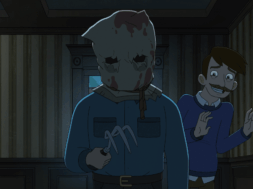There was once a time when knowledge of H.P. Lovecraft’s Cthulhu Mythos, much like the insane truths that inspired the Mad Arab’s Necronomicon, was a secretive burden carried by a small legion of nerdy horror literature fans and tabletop gaming enthusiasts. Sure, we’ve seen plenty of Lovecraft adaptations since as far back as the 1970s, but with the exception of Stuart Gordon’s ridiculously entertaining films, none of these really resonated with mainstream audiences.
Of course, since the rise of internet culture and a resurgence of interest in both tabletop role-playing games and Howard’s literary works, figures like Dagon, Cthulhu, and even Shoggoths have become household names. In gaming especially, it’s hard not to run into copious amounts of Lovecraft references when playing anything from Terraria to The Elder Scrolls series. Once an incomprehensively terrifying elder god, Cthulhu has now been immortalized and watered down in the form of plush toys and Funko Pops. Every day we’re treated to new trailers and images of Lovecraft-based/inspired media, and in some ways, it seems that the Mythos has never been so alive.
However, in a world so full of homages to H.P. Lovecraft, it seems ironic that the writer’s unique brand of existential cosmic horror still lies deathly dreaming at the bottom of the proverbial media ocean, with very few instances of media that managed to capture exactly why his work was so terrifying. That’s why I’d like to take a moment to talk about Cyanide Studio’s Call of Cthulhu, and what other Lovecraft adaptations can learn from how the game handled the Mythos. Neil already provided us with an in-depth review, so I’ll only be discussing the story here, but in case you haven’t played the game yet (which I think you definitely should), beware some minor spoilers!
An official adaptation of Chaosium’s homonymous tabletop RPG, Cyanide’s game puts players in the (gum)shoes of private investigator Edward Pierce, a traumatized World-War I veteran compelled to take on a new, mysterious case. Pierce’s investigation leads him to Darkwater Island, off the dreary coast of Massachusetts, where he must piece together the events that led to the fiery death of the infamous Hawkins family. Naturally, Lovecraftian shenanigans ensue, with unnamable creatures and ancient cults slowly pushing the unfortunate investigator towards the limits of what the human mind can handle.

This probably isn’t going to end well.
It’s a familiar setup for anyone who’s even remotely familiar with Lovecraftian tropes, but things change as the game goes on. What really sets it apart isn’t necessarily how it emulates specific story moments or ideas from the Mythos, but how it uses these same ingredients to prepare an all-new horrifying and unpredictable tale that would feel right at home in a 1920s weird fiction magazine.
Sure, there are a few characters and plot threads that don’t quite go anywhere (at least during my playthroughs), but the fascinating mythology behind Darkwater Island’s whaling history and the ominous associations with both real life and other works of fiction like Herman Melville’s classic Moby Dick make this story feel like much more than just another adaptation. While dimensional shamblers and tentacle-adorned cultists are well-trodden territory for Lovecraft enthusiasts, prohibition-era conspiracies and the terrifying effects of eldritch whale meat are wholly original story threads that help lead us to a truly apocalyptic finale.
Back in 2005, the now-defunct Headfirst Productions released their own take on the Mythos with Call of Cthulhu: Dark Corners of the Earth. While it remains one of my all-time favorite games (despite some frustrating segments and a huge list of technical issues), the developers approached the narrative like many filmmakers do, turning the story into a best-of compilation, stitching together several elements from the mythos into a smorgasbord of Lovecraftian insanity. This can work, as I believe it did in that game (although it mostly appeals to folks who are already familiar with the mythos), but most of the time this method leaves us with movies, comics, and games that adapt only the most superficial elements of Lovecraft’s literary universe. This kind of narrative almost always ends up ignoring the nuances that made silly creations like octopus-faced dragons scary in the first place.
With their take on Call of Cthulhu, Cyanide understood that Lovecraft isn’t just fish-people and tentacles (not that the game lacks these things), choosing to adapt the same creative spirit of the tabletop RPG it’s based on rather any specific story. In Chaosium’s original playing manuals, game masters would be handed the keys to a treasure trove of Lovecraftian nightmares and tasked with using the mythos as a jumping-off point to tell their own stories. These player-based narratives would usually select the best aspects of Lovecraft’s stories and expand them into something new. After all, you could only face the same few cultists and fish-monsters so many times before they became stale. Over time, by diluting the lore with their own original ideas, players would form unique narratives that still managed to stay true to Lovecraft’s original intentions.

Giant fish monsters are cool but not required!
These distinct tales could tap into intrinsically human fears and anxieties about our tiny place in a cold and uncaring universe without so much as mentioning the Great Old Ones, proving that some horrific entities are scarier when they’re felt rather than seen, and that there’s more to the mythos than the famous alien deities and fishy iconography. That’s not to say that direct and faithful adaptations of the Mythos are a bad idea (I mean, we’re all still waiting on a benevolent deity to deliver us Del Toro’s vision of At The Mountains of Madness), but writers would do well to remember that it’s more important to be faithful to the existential spirit behind these stories rather than the superficial details that most Lovecraftian media seems to go nuts over.
Some reviewers have rightly complained about Call of Cthulhu‘s false promises of an intricately tailored player-driven experience, where every minor action could have huge consequences, but no one can deny that this is one of the few adaptations that dares to look beneath the surface of Lovecraft’s tales, finding exactly what makes them tick instead of just lifting the tried-and-true aesthetics that are usually associated with the author. If anything, the illusion of choice here actually makes for a stronger and more disturbing narrative, with the oblivious investigator reluctantly setting the stage for the cultists’ endgame. Additionally, while some players might find the slow and text-heavy investigations tedious, they’re also strangely faithful to Lovecraft’s appreciation of epistolary storytelling, with the player picking up narrative pieces left behind by other characters.
Overall, the game might feel rather clunky, with several instances of stunted gameplay and outdated graphics, but much like its flawed-but-memorable 2005 predecessor, I feel that it’s destined to gain a cult following, remembered as one of the best Lovecraft adaptations to date, if not necessarily a ground-breaking video game. Hopefully, more filmmakers, game designers, and writers, in general, will take note of Cyanide’s novel approach to translating eldritch horror to modern gaming, and we’ll see some more spiritually faithful Lovecraftian media in the future, before the Great Old Ones finally awaken and decide to consume us all.









